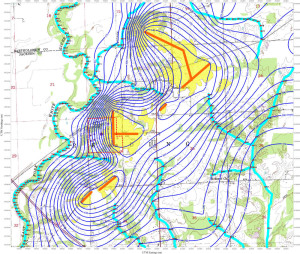Challenge
Mundell was retained by a major law firm specializing in environmental law, to provide expert witness testimony in various legal proceedings relating to a release of petroleum at a major bulk storage facility in the Midwest. Owners of neighboring properties have alleged that this release has impacted their groundwater and are suing the petroleum company for property damages. As part of the lawsuit, the organization of neighboring property owners has retained a well-known hydrogeologist to construct a groundwater flow model proving that the petroleum release has migrated onto their property.
Action
Mundell reviewed the groundwater model and the resulting conclusions, finding significant flaws in the construction of the model and the interpretation of the actual groundwater flow conditions. The next challenge Mundell faced was being able to effectively communicate relatively complex hydrogeologic concepts to people with little to no geologic background including the litigants, judges, and potential jurors in the case. To this end, Mundell utilized United States Geologic Survey (USGS) topographic maps, aerial photographs, topographic elevation data, and other published geologic information to develop high-quality visual aids using three-dimensional models to depict how groundwater moves through geologic materials in the subsurface.
Results
These visual aids were effective in helping people understand how topography and groundwater elevation maps can be used to interpret groundwater flow direction.
First, an aerial image was introduced to show people how landmarks and property features can be portrayed in map view.
Then, a topographic map of the area was added to illustrate how the same features can be portrayed on a different kind of map.
Next, a three-dimensional model of area topography was constructed to show the relationship between topographic contour lines and ground elevation.
Then, a three-dimensional model of the groundwater elevation was constructed to show how contour lines can be used to portray other types of data besides topography. This model was also used to explain the concepts of groundwater divides (orange lines) and high permeability zones (yellow areas).
Finally, the data was pulled together and presented on a single map showing actual groundwater flow conditions and highlighting deficiencies in the hydrogeologist’s model.







